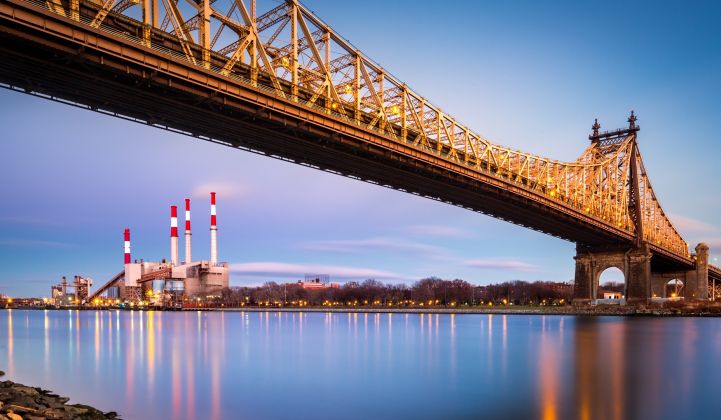In 2018, New York prioritized energy storage adoption as part of its clean energy transition strategy. Since then, energy storage development has moved faster than even the state’s policy architects expected.
A $280 million bridge incentive launched last spring to pay for some of the gap between the calculated value of energy storage and the money it can earn in the market today. The plan was to jump-start the market ahead of Gov. Andrew Cuomo’s target of having 1,500 megawatts installed by 2025; then the incentives will taper off so the industry can meet the goal of 3,000 megawatts by 2030 subsidy-free.
“Across the board, it’s grown faster than we expected it would when we scoped out the incentive and roadmap,” said Jason Doling, who oversees the energy storage program at the New York State Energy Research and Development Authority. “It was a good kind of wrong to have been.”
This storage industry growth is evident in the state’s interconnection queues. There is no guarantee that everything in the queue will be built, but a significant spike in projects listed there speaks to the general increase in development activity.
Two years ago, less than 100 megawatts' worth of storage projects had entered the queue for distribution utility interconnection, Doling said. Now, there are more than 1,000 megawatts there. In the same time frame, the storage projects in the New York Independent System Operator's bulk storage queue jumped from 1,400 megawatts to 8,000.
Among the smaller distribution-level batteries, the biggest business driver is the VDER tariff (which stands for the Value of Distributed Energy Resources). This tariff applies to batteries with up to 5 megawatts discharge capacity and pays the battery owner for the energy, capacity value and relief on the distribution system. It’s highly bankable because some of the components are locked in for 25 years, Doling noted.
Declining costs equal more energy storage projects
So far, 49 of 52 storage projects that received the smaller-scale bridge grant built their business model around VDER. Those projects maxed out the initial tranche of incentive dollars, which paid $300 per kilowatt-hour of storage capacity. But when the incentive declined to $125 per kilowatt-hour, that didn’t halt development.
“The projects still penciled [out economically] because the costs were declining,” Doling said.
That’s a positive sign that the incentive is working. It helped early adopters figure out the logistical requirements to build batteries in this particular state; when the financial support declined, the industry kept going.
Fewer bulk storage projects have advanced, given the lengthier timetable for development, but the numbers are significant.
NYSERDA has awarded bulk incentive dollars to nine projects so far, totaling 360 megawatts and almost 1,400 megawatt-hours. Those awards total $78 million, for projects that will cost $430 million.
That means the incentive covers about 18 percent of the project cost on average. It’s hard to make an apples-to-apples comparison, but that’s a lower share than other prominent subsidies that apply to batteries. The federal Investment Tax Credit for solar-paired storage covered 30 percent but stepped down to 26 percent this year; California’s Self-Generation Incentive Program typically rebates around one-third of the cost of a customer-sited battery.
Repowering old fossil plants with batteries
Other policies are motivating large storage projects. New York investor-owned utilities, for instance, are required to procure at least 350 megawatts of bulk storage dispatch rights. And a new environmental rule tightening nitrogen oxide (NOx) emissions from peaker plants is forcing owners of older and dirtier plants to consider cleaner power sources.
The queue for plant owners asking to add storage includes seven projects on Long Island totaling 600 megawatts, Doling said. In the section of the grid dubbed Zone J, which covers New York City, power plant owners filed for 16 projects totaling 1,040 megawatts.
This type of retrofit may enjoy a newfound benefit. The Federal Energy Regulatory Commission recently ruled that energy storage systems in parts of southern New York are subject to a “buyer-side mitigation” (rule that raises the bid prices of plants that draw revenue from outside the markets. However, there is some ambiguity around whether repowering an existing peaker plant with batteries, as opposed to constructing a brand new storage plant, will trigger the buyer-side mitigation rule.
New York officials and industry members are still assessing the impacts from the FERC ruling, which seems likely to make storage less competitive in the parts of the state where capacity is most valuable, an outcome at odds with state-level policy goals. But the long-term trend remains clear, Doling said.
“There is a growing appetite for storage and storage paired with intermittent [renewables] to meet peak demand,” he said. “That won’t change; that will only increase.”




